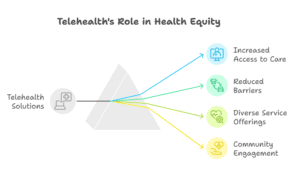Telehealth has become an essential tool in addressing healthcare disparities, providing access to care for underserved populations, and improving health equity. In South Carolina, where rural and low-income communities often face barriers to accessing quality healthcare, telehealth solutions are helping to bridge the gap. By using technology to deliver medical services remotely, South Carolina is making healthcare more accessible, efficient, and affordable for individuals who may otherwise face significant challenges in obtaining care.
In this article, we explore how telehealth solutions are promoting health equity in South Carolina, improving access to care, reducing healthcare disparities, and ensuring that all residents, regardless of location or socioeconomic status, can benefit from high-quality healthcare.
Why Health Equity is Critical in South Carolina
South Carolina, like many states, faces challenges in achieving health equity. The state has a diverse population, with significant numbers of people in rural areas, minority communities, and lower-income households who experience poorer health outcomes. Factors contributing to these disparities include:
- Limited access to healthcare providers: Rural areas in South Carolina often have a shortage of healthcare professionals, making it difficult for residents to access timely medical care.
- Transportation barriers: For many low-income and rural residents, traveling long distances to see a healthcare provider is a significant challenge.
- Health literacy and awareness: Some communities face challenges related to understanding available healthcare services and navigating the healthcare system effectively.
- Socioeconomic disparities: Income, education, and employment status play a role in healthcare access, leading to gaps in care and health outcomes.
Telehealth solutions are helping to address these challenges by improving access to medical services, particularly in underserved areas, and enhancing health outcomes for vulnerable populations.
How Telehealth Solutions Promote Health Equity in South Carolina

1. Expanding Access to Healthcare Services
Telehealth significantly improves access to healthcare services for South Carolinians, particularly in rural areas where healthcare providers are scarce. Key benefits include:
- Remote consultations: Telehealth allows patients to consult with healthcare providers via video calls or phone consultations, eliminating the need for long-distance travel.
- Access to specialists: Through telehealth, patients in remote areas can connect with specialists that may not be available locally, improving access to specialized care.
- Convenience: Patients can receive consultations from the comfort of their homes, reducing barriers such as transportation challenges or time off work.
2. Bridging the Healthcare Provider Shortage
South Carolina, like many states, has areas facing a shortage of healthcare professionals, particularly in rural regions. Telehealth helps bridge this gap by enabling healthcare providers to reach patients remotely, expanding their reach without the need to relocate or travel. Benefits include:
- Telemedicine for rural areas: Telemedicine connects patients in rural communities with physicians, specialists, and mental health professionals, overcoming geographic barriers.
- Collaboration between providers: Telehealth allows providers to collaborate across regions, ensuring that patients have access to the most appropriate care, even if it requires specialists from distant areas.
3. Reducing Health Disparities
Telehealth plays a key role in reducing health disparities by providing equitable access to care for underserved populations. This includes individuals from racial or ethnic minorities, low-income households, and rural communities. How telehealth addresses disparities:
- Affordable healthcare: Telehealth solutions are often more cost-effective than in-person visits, making it easier for low-income residents to access the care they need without incurring high out-of-pocket costs.
- Language and cultural barriers: Telehealth solutions can offer translation services or culturally competent care that meets the needs of diverse populations, enhancing accessibility for non-English-speaking residents.
- Addressing mental health needs: Telehealth has been particularly effective in addressing mental health disparities, providing virtual counseling, therapy, and psychiatric consultations for underserved populations.
4. Improving Health Outcomes through Early Intervention
Telehealth can help improve health outcomes by facilitating early diagnosis and treatment for conditions that may otherwise go untreated. How early intervention is supported:
- Chronic disease management: Telehealth solutions allow patients with chronic conditions such as diabetes, hypertension, and asthma to receive regular monitoring and support from healthcare providers, reducing complications and improving overall health.
- Preventive care: Through virtual consultations, healthcare providers can educate patients about preventive care, wellness practices, and lifestyle modifications that can help avoid more serious health issues down the road.
- Health education: Telehealth platforms can provide patients with access to educational resources, such as online workshops and materials, empowering them to take an active role in managing their health.
5. Telehealth for Maternal and Pediatric Care
Telehealth has proven to be particularly beneficial for maternal and pediatric care in underserved areas of South Carolina. How it supports maternal and child health:
- Prenatal care: Expectant mothers can consult with obstetricians via telemedicine, ensuring that they receive the necessary care and screenings without needing to travel to a clinic.
- Pediatric consultations: Pediatricians can offer virtual consultations to parents, providing guidance on their child’s health, vaccinations, and developmental milestones without the need for in-person visits.
- Improved prenatal education: Telehealth enables the delivery of prenatal education to mothers, ensuring they receive vital information on nutrition, childbirth, and postpartum care.
6. Telehealth for Elderly Care and Long-Term Health
South Carolina’s aging population benefits greatly from telehealth solutions that allow elderly individuals to receive care at home, improving both their health and quality of life. Benefits include:
- Remote monitoring: Telehealth allows for remote monitoring of vital signs and chronic conditions, ensuring that elderly patients receive the care they need without leaving home.
- Telemedicine for homebound patients: Many elderly patients may have mobility challenges, making in-person visits difficult. Telemedicine offers a way for them to access healthcare without the need to travel.
- Social isolation support: For older adults who may experience social isolation, telehealth provides a vital connection to healthcare providers and even social services, improving both mental and physical health.
7. Addressing Mental Health Needs through Telemedicine
Mental health services are critical for overall well-being, and telemedicine has proven to be highly effective in delivering mental health care remotely. How telemedicine supports mental health care:
- Access to therapy and counseling: Telehealth allows patients to access mental health professionals for counseling, therapy, and psychiatric care, reducing wait times and improving access to essential services.
- Stigma reduction: For individuals who may be hesitant to seek in-person mental health care due to stigma, telemedicine provides a more private and less intimidating way to receive treatment.
- Support for at-risk populations: Telehealth is particularly beneficial for individuals in underserved areas who face challenges in accessing in-person mental health services.
Conclusion
Telehealth is a powerful tool in promoting health equity, improving access to care, and addressing healthcare disparities in South Carolina. By enabling remote consultations, improving access to specialists, and offering affordable care, telehealth solutions help ensure that underserved populations, including those in rural areas, racial and ethnic minorities, and low-income households, receive timely and high-quality healthcare. As telehealth continues to evolve, it will play an increasingly important role in advancing health equity and improving health outcomes for all South Carolinians.
What People Are Asking
1. How does telehealth improve health equity in South Carolina?
Telehealth improves health equity by increasing access to healthcare for underserved populations, reducing barriers such as geographic location, transportation, and cost.
2. Can telehealth help with mental health services in South Carolina?
Yes, telehealth allows individuals in South Carolina, especially those in rural areas, to access mental health services such as therapy, counseling, and psychiatric care remotely.
3. How does telehealth benefit elderly patients in South Carolina?
Telehealth supports elderly patients by enabling remote monitoring of chronic conditions, offering virtual consultations, and improving access to healthcare without requiring travel.
4. What role does telehealth play in maternal and pediatric care?
Telehealth provides expectant mothers and parents with remote access to prenatal and pediatric care, improving access to essential healthcare services without the need for travel.
5. How does telehealth address healthcare access in rural areas of South Carolina?
Telehealth connects patients in rural areas to healthcare providers, offering remote consultations and reducing the need for long-distance travel, improving access to care.
Disclaimer
For informational purposes only; not applicable to specific situations.
For tailored support and professional services,
please contact Staffingly, Inc. at (800) 489-5877
Email: support@staffingly.com.
About This Blog: This Blog is brought to you by Staffingly, Inc., a trusted name in healthcare outsourcing. The team of skilled healthcare specialists and content creators is dedicated to improving the quality and efficiency of healthcare services. The team passionate about sharing knowledge through insightful articles, blogs, and other educational resources.
 Book a Demo to Build Your Team Today!
Book a Demo to Build Your Team Today!

 Read Case Studies
Read Case Studies 



 Virtual Medical Assistants
Virtual Medical Assistants



